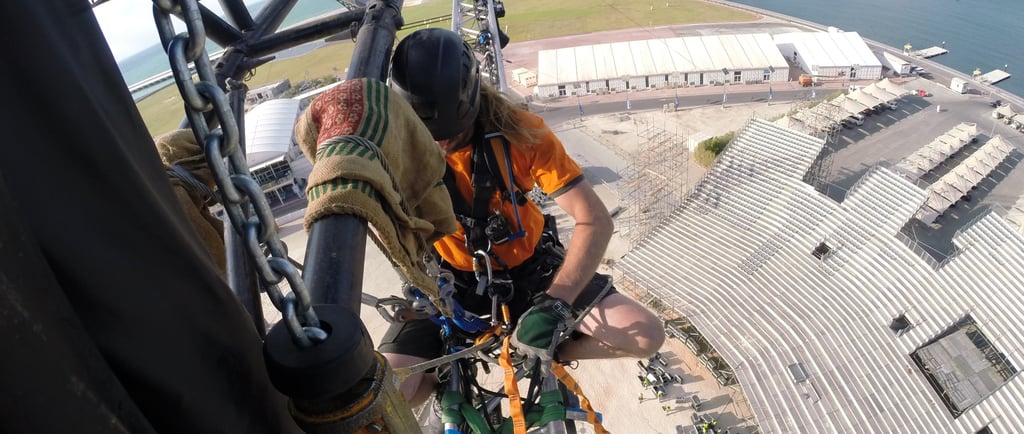Weather Safety Guidelines for Outdoor Events in the Middle East
Outdoor events in the Gulf face extreme weather risks including heat, wind gusts, dust, and humidity. Rigging, lighting, and audio crews need strict safety protocols, clear thresholds, and proactive hydration to ensure resilience, protect equipment, and safeguard teams under challenging conditions.
8/4/20254 min read


Outdoor production in the UAE, Qatar and KSA demands constant awareness of extreme weather. With high heat, sudden gusts, dust storms, and humidity, event crews need a focused and proactive safety plan. This guide is built for the specific challenges of the Gulf climate and outlines essential protocols for all teams working under open skies, from rigging, lighting, and audio teams, to power, video and stage building crews.
Rigging: Wind Gusts and Heat Are the Primary Hazards
In the Gulf, structural risk from wind comes mainly from strong gusts, not averages. Every flown element, whether it’s a roof, tower, or truss array, must have a clearly defined maximum wind speed which is set by law, and then adjusted to meet the required standard by an engineer depending on the elements being flown. This should be treated as a hard safety limit. Wind readings must be taken at one metre above the highest point of the temporary structure, with both average speeds and peak gusts logged continuously.
As gusts increase, crews should be able to fall back on an emergency weather plan, these plans are essential, as the weather can change quickly. These plans ensure there is a procedure in place to secure soft goods, open vent paths and lower flown loads where possible. Once readings climb near the limit, the fall zone must also be cleared. The rigging system’s ballast and guy lines must be kept exactly as designed. Ground conditions in the region can vary widely, dry sand provides far less hold than compacted earth or concrete, so the actual ground type must be confirmed before installation. Any change in location or setup layout should trigger a full reassessment of load and ballast positions.
Dust is a constant issue across the Gulf. Chain motors, pulleys, and rigging hardware must be cleaned regularly, and stored in sealed cases for best practice. With soaring daytime temperatures, crew climbs should be scheduled for early mornings or cooler late evenings. All slings must be certified, and mechanical fixings used wherever possible. Hydration, shade, and rest are non-negotiable to protect crew safety.
Lightning and heavy rainfall, sudden sandstorms and high humidity still require shutdown protocols, to ensure the safety of equipment and to ensure it doesn’t get damaged. Electricals should be kept elevated using weather-sealed connectors, and any water condensation should be given an outlet from canopies and structures. After sandstorms or high humidity events, every shackle, motor, and truss must be checked before operations resume. Fog can also form near the coast or desert areas overnight, Work should be delayed until the correct risk assessments have taken place, and providing it’s safe and the correct PPE is worn and in place and crews work with caution, work can continue.
Lighting: Built for Heat and Dust, Not Just Performance
In high winds, lighting fixtures, LED walls, and moving pods are vulnerable to swing or damage. Every unit must be properly clamped and safety bonded, with pan and tilt locked off. Safe trim positions or ground-level fallback options should be established in advance, so the team can act quickly when wind speeds rise.
Covers that trap air are discouraged, use open mesh materials where possible, especially for scenic elements. Dust build-up is a serious threat to lighting systems, so IP65 rated fixtures should be prioritised. Spare filters, lens cloths, and cleaning materials must be kept on site. All electrical connectors should be kept off the ground and protected from sand.
High temperatures are a constant concern. Fixtures can overheat, reduce output, or trip early when exposed to direct sunlight. Lighting power must be designed with capacity margin, racks must be ventilated, and sealed cases should not be left in the sun. LED walls in particular need rear ventilation space to avoid thermal stress.
When humidity spikes, lens faces and connectors should be wiped regularly to prevent condensation buildup. Although rainfall is rare, crews must still prepare for occasional dew or fog in early mornings. Brief power tests and short acclimatisation runs are good practice before showtime to catch potential issues early.
Audio: Wind, Dust, and Heat Management is Critical
Line arrays and flown audio behave like sails in windy conditions. Clearly defined wind thresholds must be in place to rotate, lower, or ground-stack arrays and set safe trims for delay towers. Front fills and delay speakers must be fixed using positive locking hardware, not sandbags or loose weights. Speaker stands should be secured with straps or locking pins.
With dust storms frequent, amp racks should be fully ventilated and sealed where possible. Stage boxes should be protected, and microphones fitted with full foam or basket windscreens. Consoles must be covered when idle, and cable routing must be protected to maintain safety during low visibility or dusty conditions.
Heat poses a risk to headroom and may trigger thermal protection systems. The mixing position should be shaded, amp racks ventilated, and care taken with EQ adjustments, especially during humid evenings. Excessive heat also increases the risk of sudden shutdowns, so equipment should not be overdriven.
While rain is rarely a major concern, morning dew or evening humidity can create condensation in microphone capsules and fader tracks. Equipment should be allowed to reach ambient temperature before being opened or powered on. Crew comms systems should always be tested early in the day to confirm paging and talkback functions, especially after a humid night.
Conclusion: Stay Weather-Wise and Crew-Ready
Producing live events in the Middle East means working in extreme and often unpredictable conditions. High wind gusts, extreme heat, dust, and humidity require early planning, clear thresholds, and decisive action. Every department, rigging, lighting, and audio, must understand their weather triggers and work with safety-first protocols.
Event success in the UAE, Qatar and KSA isn’t just about equipment and programming, it’s about respecting the climate and planning ahead. The weather doesn’t wait. Neither should your safety plan.
Ready to make your next event sound exactly as it should? Contact our team or explore our audio solutions to learn more.
We are an AV and engineering company offering technical consultancy, venue support, and equipment solutions for AV and rigging needs.
© 2024. All rights reserved.


Qatar
Saudi Arabia
United Arab Emirates
Building 141, Street 3087, Zone 91 Birkat Al-Awamer, Doha, Qatar
+966 53 251 4423
Office: 4404 Abdullah bin Saud bin Abdulaziz Road, Al-Shuhada neighbourhood, Postal code 13241
Warehouse 10 DIP 2, Plot number: 597 4904 24°58'42.8"N 55°11 - 41 8"E - Dubai
Warehouse: Al Shifa, Uqadh, Riyadh 14726, Saudi Arabia
